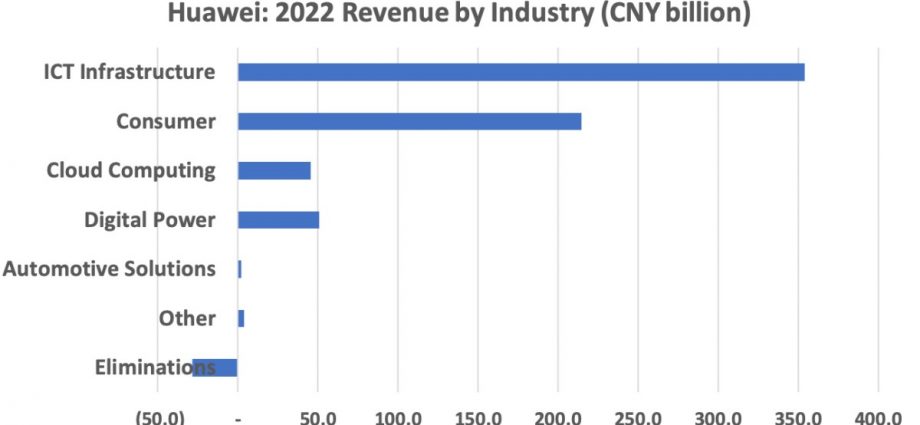Huawei’s financial results for 2022 show a slight increase in revenue, steep declines in operating and net profit but no red ink, and a sound balance sheet.
Considering last year’s Covid lockdown, inflation and the need to work around US sanctions, the Chinese telecom company turned in an admirable performance. Huawei’s operating margin was 6.6%, ROE was 8.1% and the company finished 2022 with net cash equal to 40% of equity.
Total revenue was up 0.9% to 642.3 billion yuan (US$92.4 billion). Sales to telecom carriers were also up 0.9%, sales to corporate enterprises up 30% and automotive and other sales up 13.6%. Consumer sales were down 11.9% over the same period.
A breakdown of sales by industry was provided for the first time, showing information and communication technology (ICT) infrastructure accounting for 55% of the total, consumer products for 33%, cloud computing for 7%, digital power for 8%, and automotive solutions and other products for 1%, with eliminations of internal transactions subtracting 4%.
This demonstrates the radical reorientation of Huawei’s operations following the American assault on its smartphone business. In 2018, before sanctions were imposed, phone and other consumer product sales rose 45% to account for almost half of the company’s total sales.
ICT infrastructure, which is sold both to telecom carriers and corporate enterprises, includes the 5G-networked factory and logistics automation systems that are transforming China from the low-wage “workshop of the world” into a self-claimed leader of the dawning Fourth Industrial Revolution.
Consumer products include mobile phones, wearable devices, PCs and tablets. Huawei’s cell phone business may be down, but it is not out.
Cloud computing includes storage, network, security and database services. Digital power covers photovoltaics, data center facilities, and drive control, battery safety and electronic device fault prediction for electric vehicles. Automotive solutions mostly involve the sale of components and accessories to vehicle manufacturers.

Huawei’s regional sales breakdown in 2022 was China 63%, EMEA (Europe, the Middle East and Africa) 23%, Asia-Pacific 7.5%, the Americas 5% and other regions less than 2%.
With sales banned in the US and Canada, the Americas effectively means Latin America. In addition, Huawei’s business is restricted in Europe, Japan, South Korea, India and Australia.
During the year, sales were down 2.3% in China, up 13.5% in EMEA, down 10.5% in Asia-Pacific, up 9.1% in the Americas and mostly flat in other regions.

The cost of goods sold (COGS) increased by 9.4%, leading to an 8.3% decline in gross profit and a year on year decline in gross margin from 48.3% to 43.9%.
R&D spending was up 13.2%, selling, general and administrative (SG&A) expenses were up 5.4%. However, other net income was down by almost half, resulting in a 65.2% drop in operating profit and a decline in operating margin from 19.1% to 6.6%. Total personnel expenses were up 7.5%. The company’s net profit dropped 68.7% and net margin declined from 17.9% to 5.5% compared to 2021.
Speaking at Nanjing University, Huawei founder Ren Zhengfei said that Huawei had replaced more than 13,000 imported components with alternatives made in China and redesigned more than 4,000 circuit boards in order to avoid US sanctions.
The company also plans to introduce its own enterprise resource planning (ERP) system, The South China Morning Post reported on March 19. It was necessary and should contribute to the company’s stability and technological edge in the future, but it wasn’t likely cheap.
Financial and other non-operating income and expenses were not significant, but the company’s effective tax rate rose from 6.7% to 19.1%.

Huawei’s financial results were in line with management’s forecast and are detailed in its Annual Report, required reading for anyone with a serious interest in Huawei’s business and development plans. Huawei’s financial statements were audited by accountants at KPMG Huazhen LLP, Shenzhen.
Looking ahead, Huawei Rotating Chairman Eric Xu told the press:
“2023 will be crucial to Huawei’s sustainable survival and development. Plum blossoms tend to grow sweeter from a harsh winter’s freeze. Today, Huawei is like a plum blossom. While it’s true that we have considerable pressure ahead of us, we have what it takes to come out the other end – with opportunities to grow, a resilient business portfolio, a unique competitive edge, the enduring trust of our customers and partners, and the courage to invest heavily in R&D. We are confident in our ability to rise above any challenge that comes our way, laying a solid foundation for sustainable survival and development.”
Earlier this year the US Commerce Department had stopped approving most applications for licenses to export products containing American technology to Huawei and that it may issue a complete ban in the near future, according to reports.
It is hard to predict the impact of these actions, but judging from developments so far, they are more likely to galvanize than hobble Huawei.
Follow this writer on Twitter: @ScottFo83517667

